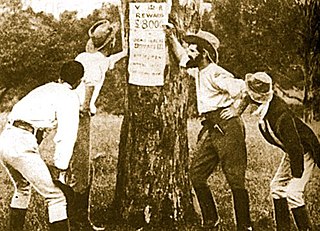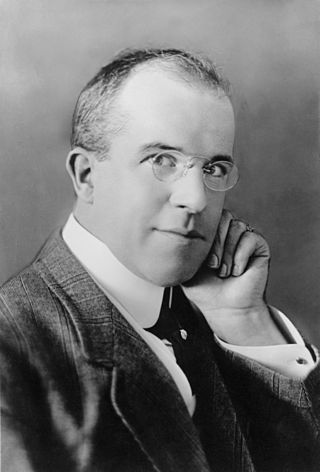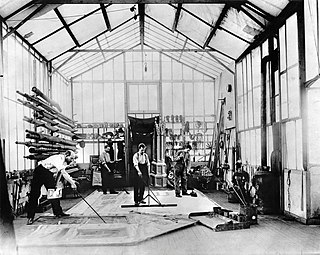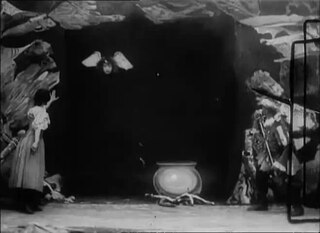Related Research Articles
The year 1908 in film involved some significant events.

The year 1906 in film involved some significant events.
The year 1905 in film involved some significant events.
The year 1900 in film involved some significant events.
The following is an overview of the events of 1898 in film, including a list of films released and notable births. The Spanish–American War was a popular subject. Several films made by Col. William N. Selig dealt with the subject of war preparations at Camp Tanner in Springfield, Illinois, including Soldiers at Play, Wash Day in Camp and First Regiment Marching.

James Stuart Blackton was a British-American film producer and director of the silent era. One of the pioneers of motion pictures, he founded Vitagraph Studios in 1897. He was one of the first filmmakers to use the techniques of stop-motion and drawn animation, is considered a father of American animation, and was the first to bring many classic plays and books to the screen. Blackton was also the commodore of the Motorboat Club of America and the Atlantic Yacht Club.
The silent age of American animation dates back to at least 1906 when Vitagraph released Humorous Phases of Funny Faces. Although early animations were rudimentary, they rapidly became more sophisticated with such classics as Gertie the Dinosaur in 1914, Felix the Cat, Oswald the Lucky Rabbit, and Koko the Clown.

A Trip to the Moon is a 1902 French science-fiction adventure trick film written, directed and produced by Georges Méliès. Inspired by Jules Verne's 1865 novel From the Earth to the Moon and its 1870 sequel Around the Moon, the film follows a group of astronomers who travel to the Moon in a cannon-propelled capsule, explore the Moon's surface, escape from an underground group of Selenites, and return to Earth with a captive Selenite. Méliès leads an ensemble cast of French theatrical performers as the main character Professor Barbenfouillis.

George Albert Smith was an English stage hypnotist, psychic, magic lantern lecturer, Fellow of the Royal Astronomical Society, inventor and a key member of the loose association of early film pioneers dubbed the Brighton School by French film historian Georges Sadoul. He is best known for his controversial work with Edmund Gurney at the Society for Psychical Research, his short films from 1897 to 1903, which pioneered film editing and close-ups, and his development of the first successful colour film process, Kinemacolor.

Actuality film is a non-fiction film genre that uses footage of real events, places, and things, a predecessor to documentary film. Unlike documentaries, actuality films are not structured into a larger narrative or coherent whole. During the era of early cinema, actualities—usually lasting no more than a minute or two and usually assembled together into a program by an exhibitor—were just as popular and prominent as their fictional counterparts. The line between "fact" and "fiction" was not as prominent in early cinema as it would become once documentaries became the predominant non-fiction filmmaking form. Actuality as a film genre is related to still photography.

In comedy, a visual gag or sight gag is anything which conveys its humour visually, often without words being used at all. The gag may involve a physical impossibility or an unexpected occurrence. The humor is caused by alternative interpretations of the goings-on. Visual gags are used in magic, plays, and acting on television or movies.

A Midsummer Night's Dream is a 1909 American film directed by Charles Kent and J. Stuart Blackton, and starring Walter Ackerman and Charles Chapman. It was the first film adaptation of the eponymous play by William Shakespeare. The movie was made during summer 1909, but not released until December 25.

Georges Méliès (1861–1938) was a French filmmaker and magician generally regarded as the first person to recognize the potential of narrative film. He made about 520 films between 1896 and 1912, covering a range of genres including trick films, fantasies, comedies, advertisements, satires, costume dramas, literary adaptations, erotic films, melodramas, and imaginary voyages. His works are often considered as important precursors to modern narrative cinema, though some recent scholars have argued that Méliès's films are better understood as spectacular theatrical creations rooted in the 19th-century féerie tradition.

The Kingdom of the Fairies, initially released in the United States as Fairyland, or the Kingdom of the Fairies and in Great Britain as The Wonders of the Deep, or Kingdom of the Fairies, is a 1903 French silent trick film directed by Georges Méliès.

Marie-Georges-Jean Méliès was a French magician, actor, and film director. He led many technical and narrative developments in the early days of cinema, primarily in the fantasy and science fiction genres. Méliès rose to prominence creating "trick films" and became well known for his innovative use of special effects, popularizing such techniques as substitution splices, multiple exposures, time-lapse photography, dissolves, and hand-painted colour. He was also one of the first filmmakers to use storyboards in his work. His most important films include A Trip to the Moon (1902) and The Impossible Voyage (1904).

Explosion of a Motor Car is a 1900 British silent comic trick film, directed by Cecil M. Hepworth, featuring an exploding automobile scattering the body parts of its driver and passenger. "One of the most memorable of early British trick films" according to Michael Brooke of BFI Screenonline, "was one of the first films to play with the laws of physics for comic effect." It features one of the earliest known uses in a British film of the stop trick technique discovered by French filmmaker Georges Méliès in 1896, and also includes one of the earliest film uses of comedy delay – later to be widely used as a convention in animated films – where objects take much longer to fall to the ground than they would do in reality. It is included in the BFI DVD Early Cinema: Primitives and Pioneers and a clip is featured in Paul Merton's interactive guide to early British silent comedy How They Laughed on the BFI website.

The Magic Sword; or, A Medieval Mystery is a 1901 British silent fantasy trick film, directed by Walter R. Booth, featuring a mediaeval knight battling to save a damsel from an ogre and a witch. The film, "is impressively elaborate, with single shots containing multiple trick effects achieved through complex double exposures and superimpositions," and according to Michael Brooke of BFI Screenonline, "was so startling that it moved the legendary stage illusionist J.N. Maskelyne to describe The Magic Sword as the finest trick film made up to then."

The Christmas Dream is a 1900 French silent Christmas-themed trick film directed by Georges Méliès. It was released by Méliès's Star Film Company and is numbered 298–305 in its catalogues, where it was advertised as a féerie cinématographique à grand spectacle en 20 tableaux.

The Twentieth Century Tramp; or, Happy Hooligan and His Airship is an American silent short film produced and directed by Edwin S. Porter and released in 1902. This film is an adaptation of the cartoon Happy Hooligan, played by J. Stuart Blackton.
Une indigestion, sold in the United States as Up-to-Date Surgery and in Britain as Sure Cure for Indigestion, and also known as Chirurgie fin de siècle, is a 1902 French short silent film by Georges Méliès.
References
- 1 2 Solomon 2006 , p. 596
- 1 2 3 Carroll 1996 , p. 146
- ↑ Kirby, Lynne (1997), Parallel Tracks: The Railroad and Silent Cinema, Durham: Duke University Press, ISBN 0822318393
- 1 2 3 Parkinson, David (2012), 100 Ideas That Changed Film, London: Laurence King Publishing, p. 19
- ↑ Gunning, Tom (2005), "The Cinema of Attractions: Early Film, Its Spectator, and the Avant-Garde", in Knopf, Robert (ed.), Theater and Film: A Comparative Anthology, New Haven: Yale University Press, p. 39, ISBN 0300128703
- ↑ Low, Rachael (1997), History of British Film, vol. 2, London: Routledge, p. 180, ISBN 9780415156479
- ↑ Carroll 1996 , p. 156
- ↑ Solomon 2006 , pp. 602–3